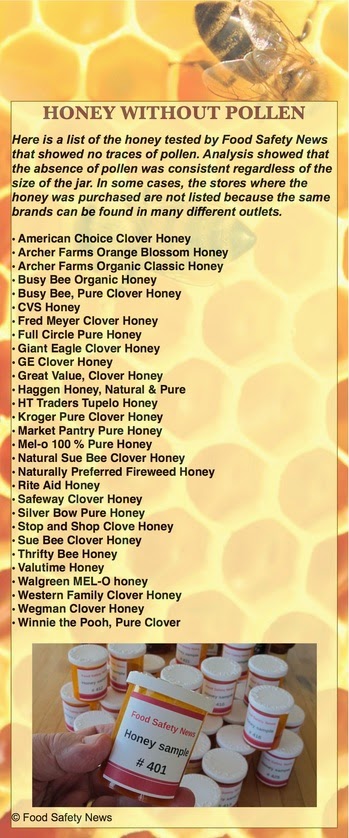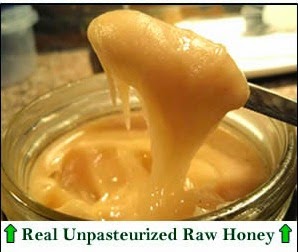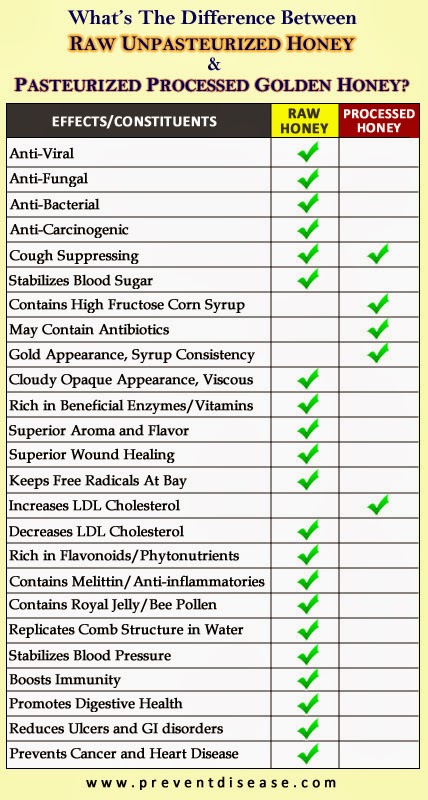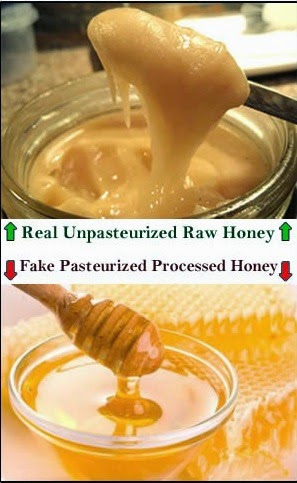Honey - ask questions and buy local
Shocking Differences Between Raw Honey And Processed Honey Found In Stores
By Karen Foster
There are well over 30 commercial producers of honey that have no traces of pollen and lack beneficial vitamins and enzymes among a host of other natural constituents which are removed due to pasteurization and processing.
Most golden honey you see at your local grocery is dead and far from the health promoting powerhouse of its raw unpasteurized counterpart. Processed honey is not honey at all and if you desire any kind of health benefits, you must stick to the real stuff.
In the U.S., the Food and Drug Administration says that any product that’s been ultra-filtered and no longer contains pollen isn’t honey.
However, the FDA isn’t checking honey sold in the U.S. to see if it contains pollen.
Ultra filtering is a high-tech procedure where honey is heated, sometimes watered down and then forced at high pressure through extremely small filters to remove pollen, which is the only foolproof sign identifying the source of the honey. It is a spin-off of a technique refined by the Chinese, who have illegally dumped tons of their honey — some containing illegal antibiotics — on the U.S. market for years.
Food Safety News decided to test honey sold in various outlets after its earlier investigation found U.S. groceries flooded with Indian honey banned in Europe as unsafe because of contamination with antibiotics, heavy metal and a total lack of pollen which prevented tracking its origin.
They purchased more than 60 jars, jugs and plastic bears of honey in 10 states and the District of Columbia.
The contents were analyzed for pollen by Vaughn Bryant, a professor at Texas A&M University and one of the nation’s premier melissopalynologists, or investigators of pollen in honey.
Bryant, who is director of the Palynology Research Laboratory, found that among the containers of honey provided by Food Safety News, 76 percent or more had the pollen removed including stores such as Walgreens, Costco, Walmart, Sam’s Club, TOP Food, Safeway, Giant Eagle, QFC, Kroger, Metro Market, Harris Teeter, A&P, Stop & Shop and King Soopers.
Why Remove the Pollen?
 We can only assume to prevent the majority of the public from obtaining all the benefits found in raw honey. Removal of all pollen from honey “makes no sense” and is completely contrary to marketing the highest quality product possible, Mark Jensen, president of the American Honey Producers Association, told Food Safety News.
We can only assume to prevent the majority of the public from obtaining all the benefits found in raw honey. Removal of all pollen from honey “makes no sense” and is completely contrary to marketing the highest quality product possible, Mark Jensen, president of the American Honey Producers Association, told Food Safety News.
“I don’t know of any U.S. producer that would want to do that. Elimination of all pollen can only be achieved by ultra-filtering and this filtration process does nothing but cost money and diminish the quality of the honey,” Jensen said.
“In my judgment, it is pretty safe to assume that any ultra-filtered honey on store shelves is Chinese honey and it’s even safer to assume that it entered the country uninspected and in violation of federal law,” he added.
What’s Wrong With Chinese Honey?
Chinese honey has long had a poor reputation in the U.S., where — in 2001 — the Federal Trade Commission imposed stiff import tariffs or taxes to stop the Chinese from flooding the marketplace with dirt-cheap, heavily subsidized honey, which was forcing American beekeepers out of business.
To avoid the dumping tariffs, the Chinese quickly began transshipping honey to several other countries, then laundering it by switching the color of the shipping drums, the documents and labels to indicate a bogus but tariff-free country of origin for the honey.
Most U.S. honey buyers knew about the Chinese actions because of the sudden availability of lower cost honey, and little was said.
The FDA — either because of lack of interest or resources — devoted little effort to inspecting imported honey. Nevertheless, the agency had occasionally either been told of, or had stumbled upon, Chinese honey contaminated with chloramphenicol and other illegal animal antibiotics which are dangerous, even fatal, to a very small percentage of the population.
Mostly, the adulteration went undetected.
What’s Are Differences Between Raw Unpasteurized Honey and Pasteurized Processed Golden Honey?
The processing of honey often removes many of the phytonutrients found in raw honey as it exists in the hive. Raw honey, for example, contains small amounts of the same resins found in propolis. Propolis, sometimes called “bee glue,” is actually a complex mixture of resins and other substances that honeybees use to seal the hive and make it safe from bacteria and other micro-organisms. Honeybees make propolis by combining plant resins with their own secretions. However, substances like road tar have also been found in propolis.
Bee keepers sometimes use special screens around the inside of the hive boxes to trap propolis, since bees will spread this substance around the honeycomb and seal cracks with the anti-bacterial, anti-viral, and anti-fungal resins. The resins found in propolis only represent a small part of the phytonutrients found in propolis and honey, however. Other phytonutrients found both in honey and propolis have been shown to posssess cancer-preventing and anti-tumor properties. These substances include caffeic acid methyl caffeate, phenylethyl caffeate, and phenylethyl dimethylcaffeate.
Researchers have discovered that these substances prevent colon cancer in animals by shutting down activity of two enzymes,phosphatidylinositol-specific phospholipase C and lipoxygenase. When raw honey is extensively processed and heated, the benefits of these phytonutrients are largely eliminated.
Speakers at the First International Symposium on Honey and Human Health, presented a number of research papers. The research was applied to raw unpasteurized honey and the findings included:
- FRIENDLY BACTERIA – Different varietals of honey possess a large amount of friendly bacteria (6 species of lactobacilli and 4 species of bifidobacteria), which may explain many of the “mysterious therapeutic properties of honey.”
- Lactobacilli, which deliver protective and beneficial benefits to bees as well as humans, were not found in the bees’ honey stomach during the winter months when the bees under investigation were fed sucrose, indicating that certain bee-feeding practices may have dangerous and unwanted effects on bees.
- BLOOD SUGAR CONTROL – Honey may promote better blood sugar control. Proper fueling of the liver is central to optimal glucose metabolism during sleep and exercise. Honey is the ideal liver fuel because it contains a nearly 1:1 ratio of fructose to glucose. Fructose “unlocks” the enzyme from the liver cell’s nucleus that is necessary for the incorporation of glucose into glycogen (the form in which sugar is stored in the liver and muscle cells). An adequate glycogen store in the liver is essential to supply the brain with fuel when we are sleeping and during prolonged exercise. When glycogen stores are insufficient, the brain triggers the release of stress hormones–adrenalin and cortisol–in order to convert muscle protein into glucose. Repeated metabolic stress from cortisol produced when less than optimal liver glycogen stores are available during sleep, leads over time, to impaired glucose metabolism, insulin resistance, diabetes, and increased risk for cardiovascular disease and obesity.
- Experimental evidence indicates that consumption of honey may improve blood sugar control and insulin sensitivity compared to other sweeteners. The body’s tolerance to honey is significantly better than to sucrose or glucose alone. Individuals with greater glucose intolerance (e.g., those with mild diabetes and Type 1 diabetes) showed significantly better tolerance to honey than sucrose. In addition, the antioxidants in honey, which have been shown to reduce oxidative stress, frequently by a larger factor than can be explained by their actual amount, may be beneficial for diabetics and help to improve endothelial function (the function of the cells that make up the lining of our blood vessels) and vascular health.
- WEIGHT MANAGEMENT – In a year-long animal study comparing the effects of sucrose, honey and a low glycemic index (GI) sugar-free diet, rats on the honey-based diet showed: reduced weight gain and percentage of body fat, decreased anxiety, better spatial recognition memory, improved HDL cholesterol (15-20% higher than rats fed sugar or sucrose diets), improved blood sugar levels (HA1c), and reduced oxidative damage.
- COUGH SUPPRESSANT – Honey has been shown to be a more effective cough suppressant for children ages 2-18 than dextromethorphan (see “One Study Finds Buckwheat Honey To Be a Successful Cough Medicine” earlier in this Health Benefits section)
- BOOSTS IMMUNITY – Honey boosts immunity. Research conducted in several hospitals in Israel found honey effective in decreasing the incidence of acute febrile neutropenia (when high fever reduces white blood cell count) in 64% of patients. Honey also reduced the need for Colony Stimulating Factor (a compound produced in the cells lining the blood vessels that stimulate bone marrow to produce more white blood cells) in 60% of patients with acute febrile neutropenia; increased neutrophil count (another type of white blood cell), decreased thrombocytopenia (low platelet count), and stabilized hemoglobin levels at >11 gm/dl (a bit low but way better than full blown anemic).
- 32% of the cancer patients involved in the above immunity research reported improved quality of life.
- WOUND HEALING – Several mechanisms have been proposed for the wound healing benefits that are observed when raw honey is applied topically. Because honey is composed mainly of glucose and fructose, two sugars that strongly attract water, honey absorbs water in the wound, drying it out so that the growth of bacteria and fungi is inhibited (these microorganisms thrive in a moist environment). Secondly, raw honey contains an enzyme called glucose oxidase that, when combined with water, produces hydrogen peroxide, a mild antiseptic. Previous studies have shown that Manuka honey decreases the surface pH of wounds (so germs can’t survive) and can help keep bacteria out. While all honey does contain anti-bacterial properties, commercial honey is usually pasteurized and processed, which decreases its beneficial properties. Manuka honey is special because it produces a different substance called methylglyoxal, which has unique antibacterial activity.
- ANTI-BACTERIAL – One antioxidant absent in pasteurized honey ispinocembrin, which is unique to honey and is currently being studied for its antibacterial properties. One laboratory study of unpasteurized honey samples indicated the majority had antibacterial action againstStaphylococcus aureus, a common bacteria found readily in our environment that can cause infections, especially in open wounds. Other reports indicate honey is effective at inhibiting Escherichia coliand Candida albicans. Darker honeys, specifically honey from buckwheat flowers, sage and tupelo, contain a greater amount of antioxidants than other honeys, and raw, unprocessed honey contains the widest variety of health-supportive substances.
- FREE RADICAL PREVENTION – Daily consumption of raw honey raises blood levels of protective antioxidant compounds in humans, according to research presented at the 227th meeting of the American Chemical Society in Anaheim, CA, March 28, 2004. Biochemist Heidrun Gross and colleagues from the University of California, Davis, gave 25 study participants each about four tablespoons buckwheat honey daily for 29 days in addition to their regular diets, and drew blood samples at given intervals following honey consumption. A direct link was found between the subjects’ honey consumption and the level of polyphenolic antioxidants in their blood.
- HELPS HIGH CHOLESTEROL – In a series of experiments involving healthy subjects and those with either high cholesterol or type 2 diabetes, honey has proved itself the healthiest sweetener.
In healthy subjects, while sugar and artificial honey had either negative or very small beneficial effects, natural honey reduced total cholesterol 7%, triglycerides 2%, C-reactive protein 7%, homocysteine 6% and blood sugar 6%, and increased HDL (good) cholesterol 2%. (Like C-reactive protein, homocysteine is a significant risk factor for cardiovascular disease.)
In patients with high cholesterol, artificial honey increased LDL (bad) cholesterol, while natural honey decreased total cholesterol 8%, LDL cholesterol 11%, and C-reactive protein 75%.
And in patients with type 2 diabetes, natural honey caused a significantly lower rise in blood sugar than either dextrose or sucrose (refined sugars). So, enjoy a little honey in your morning coffee, lunchtime yogurt or afternoon cup of green tea. Looks like a daily spoonful of honey may help your need for medicine go down.
How Can You Tell The Difference Between Pure Honey and Artificial Honey?
Inverted sugar solutions and glucose syrups or corn are often used for making fake honey, mixing with it, or replacing it entirely.
Another method for falsification of honey is feeding bees with sugar products.
The “innocent” method of honey falsification is the addition of water (honey containing more than 25% water, is considered to be falsified)
Worldwide, adulterated honey is deemed, counterfeiting ranks second among the food industry – the extra virgin olive oil.
Artificial honey is a food with many shortcomings, representing a solution of invert sugar syrup, which comes from refined sugar, which often add other ingredients, generally summarized as: glucose syrup, dyes, flavors and enhancer flavors. Such a synthetic preparation can be achieved in domestic conditions, but you need to know it is not healthy. Artificial honey contains a physical mixture of glucose and fructose focused elements that have separated from the previous combination, that of sucrose (sugar). It is known that both are in high concentrations, even more dangerous than the original form, crystalline carbohydrates entering the category of very rapid absorption substances.
Artificial inverted sugar, also called artificial honey, is a syrup, soluble in water, with sweet taste, resulted from the hydrolysis of sucrose. It is widely used in food industry as sweetener, attracting criticism from many nutritionists and doctors.
4 WAYS TO SPOT ARTIFICIAL HONEY
1. The Thumb Test
Put a drop of the honey on your thumb. If it spreads around right away or spills, it’s not pure. If it stays intact, it’s pure.
2. The Water Test
Fill a glass of water and add one tablespoon of “honey” into the water. Pure honey will lump and settle at bottom of glass. Adulterated and artificial honey will start dissolving in water.
3. The Shelf Life Test
Pure honey will crystallize over time. Imitation honey will remain looking like syrup, no matter how long it is stored.
4. Light a Fire
Dip the tip of a matchstick in “honey”, and then strike it to light. Natural honey will light the match easily and the flame will burn off the honey. Fake honey will not light because of the moisture it contains.
Comment
-
Comment by Christopher on December 15, 2015 at 4:43pm
-
Thanks for this very informative post.
"Destroying the New World Order"
THANK YOU FOR SUPPORTING THE SITE!
Latest Activity
- Top News
- ·
- Everything
What was the Significance of the F-94 C and What role in History?
FLUORIDEGATE: An American Tragedy. a film by Dr. David Kennedy
Rendezvous With The Unknown
Shadows in the Wind
Mossad: we create a pretend world, we are a global production company... the world is our stage
© 2025 Created by truth.
Powered by
![]()



You need to be a member of 12160 Social Network to add comments!
Join 12160 Social Network